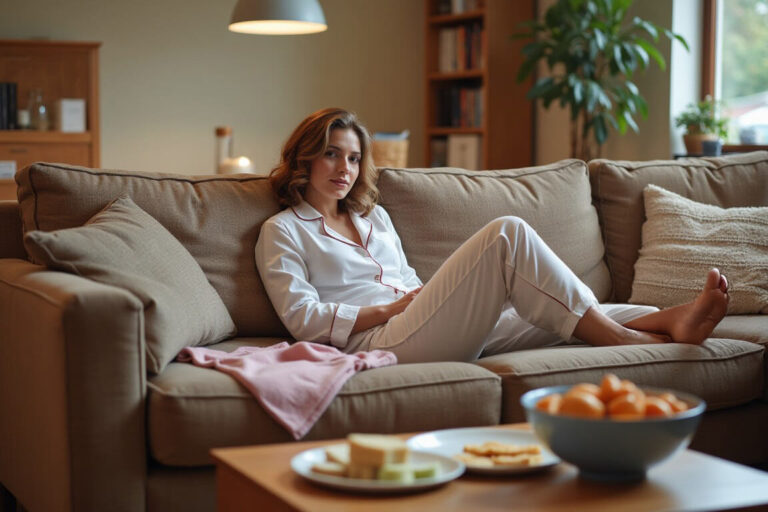Living a sedentary lifestyle can affect many aspects of your well-being. For those who find themselves spending most of their day sitting or inactive, especially at home, making changes can improve both physical health and emotional balance.
Recognizing the need to move more is the first step toward a healthier, more energetic life.

Photo by Adil
Understanding what it means to lead a sedentary lifestyle at home
Being inactive for long periods, often called a sedentary lifestyle, can develop unintentionally when daily routines involve minimal physical activity. This pattern may arise from managing household duties or simply falling into habits of rest and screen time.
The consequences of inactivity include weight gain, increased risk of chronic illnesses, and reduced energy. It can also affect mental health, leading to feelings of lethargy or low motivation.
Additionally, inactivity may impact relationships, especially when it limits shared activities or creates stress due to health concerns.
Introducing practical strategies to increase daily movement
Changing a sedentary routine requires actionable steps that fit into everyday life. Establishing a plan that includes small, consistent changes can make physical activity approachable and sustainable.
By focusing on achievable goals rather than drastic changes, you build momentum that encourages long-term success.
These strategies will help transform inactivity into a habit of movement.
Allocating dedicated time for exercise each day
Setting aside a specific time for physical activity creates structure and prioritizes health.
Even 15 minutes daily can jumpstart your routine. Gradually increasing this duration helps build endurance without overwhelming your schedule.
Consistency is key; treat this time as an essential appointment with yourself.
Selecting enjoyable activities to stay motivated
Choosing physical activities you genuinely like increases the likelihood of sticking with them.
Whether it’s walking, dancing, gardening, or swimming, enjoyment fuels commitment.
Explore different options to find what brings you joy and makes movement feel less like a chore.
Starting with manageable effort and progressing steadily
Beginning with short, gentle sessions prevents burnout and injury.
Increasing intensity and time gradually allows your body to adapt and improves stamina.
This approach keeps motivation high and helps establish exercise as a natural part of your day.

Photo by Leah Newhouse
Partnering with someone for accountability and support
Having a workout buddy provides encouragement and makes exercising more enjoyable.
Friends or family members can help keep you accountable and celebrate progress together.
Sharing your goals creates a support system that strengthens commitment.
Incorporating exercise into daily habits
Making physical activity a daily ritual, much like brushing your teeth, builds consistency.
This can include stretching in the morning, short walks during breaks, or simple at-home workouts.
Embedding movement in your routine reduces the chance of skipping exercise.
Rewarding yourself to maintain motivation
Setting tangible fitness goals and celebrating achievements keeps enthusiasm high.
Rewards might include new workout clothes, a relaxing bath, or a favorite healthy treat.
Recognizing progress reinforces positive behavior and encourages ongoing effort.
Handling setbacks with resilience
Temporary obstacles or missed workouts are normal and should not derail your progress.
Viewing setbacks as learning moments helps you recover quickly and stay focused on long-term goals.
Maintaining a flexible mindset supports sustainable lifestyle changes.
Adding movement to everyday activities
Simple changes like choosing stairs over elevators, parking farther away, or pacing during phone calls increase daily activity.
These small actions accumulate and contribute significantly to overall fitness.
Being mindful of opportunities to move throughout the day keeps your body active without requiring extra time.
Creating an inviting space for exercise at home
Designating a specific area with easy access to workout equipment encourages regular exercise.
Having gear like mats, weights, or resistance bands visible and ready removes barriers to starting.
A welcoming workout environment makes it simpler to commit to physical activity.
Trying various forms of exercise to find what fits best
Exploring different activities such as yoga, Pilates, or group fitness classes keeps routines fresh and engaging.
Variety challenges your body in new ways and prevents boredom.
Experimentation helps identify exercises that suit your preferences and lifestyle.

Photo by Leeloo The First
Real-life stories showing progress from inactivity to active living
Maria, a stay-at-home mom, found herself spending hours on the couch after her children went to school. By scheduling 20-minute morning walks, she gradually rebuilt her energy and mood. Her husband joined her on weekends, turning exercise into quality family time.
Another example is Lisa, who struggled with motivation until she created a small workout corner in her living room. Having her yoga mat and weights within reach made it easier to start. She rewarded herself with a favorite smoothie after each session, reinforcing her new habits.
Both stories highlight the power of small changes, social support, and environment in overcoming a sedentary lifestyle.
Summary of key steps to becoming more active
Overcoming inactivity involves setting clear goals, building consistent habits, and finding joy in movement.
Utilize support systems, create inviting spaces, and remain patient through setbacks.
With dedication and practical strategies, a more vibrant, healthier lifestyle is within reach.


